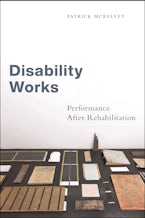
Disability Works
Performance After Rehabilitation
Published by: NYU Press
Series: Performance and American Cultures
Imprint: NYU Press
344 Pages, 6.00 x 9.00 in, 9 b/w images
Description
A cultural history of disability, performance, and work in the modern United States
In 1967, the US government funded the National Theatre of the Deaf, a groundbreaking rehabilitation initiative employing deaf actors. This project aligned with the postwar belief that transforming bodies, minds, aesthetics, and institutions could liberate disabled Americans from economic reliance on the state, and demonstrated the growing optimism that performance could provide job opportunities for people with disabilities.
Disability Works offers an original cultural history of disability and performance in modern America, exploring rehabilitation’s competing legacies. The book highlights an unexpected alliance of rehabilitation professionals, deaf teachers, policy makers, disability activists, queer artists, and religious leaders who championed performance’s rehabilitative potential. At the same time, some disabled artists imagined a different political itinerary for theatrical practice. Rather than acquiescing to the terms of productive citizenship, these artists recuperated rehabilitation as a creative resource for imagining and building a world beyond work. Using previously unexplored archives, Disability Works portrays the history of disabled Americans’ performance labor as both a national aspiration and a national problem. The book reveals how disabled artists and activists ingeniously used rehabilitative resources to fuel their performance practices, breaking free from the grasp of rehabilitation and fostering more just institutions.
From state-funded “sign-mime” to Black modern dance, community theatre to Stanislavskian actor training, speculative activism to epistolary performance, Disability Works recovers an expansive repertoire of aesthetic and infrastructural investigations into the terms of how disability works in modern American culture.
